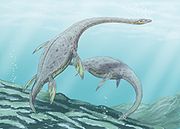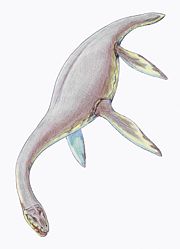
Cryptoclididae
Encyclopedia
Cryptoclididae is a family
of medium-sized plesiosaur
s that lived from the Middle Jurassic
to the Late Cretaceous
. In 2010, Kaiwhekea
was transferred to Leptocleididae
and Aristonectes
was transferred to Elasmosauridae
.
 They had long necks, broad and short skulls and densely packed teeth. They fed on small soft-bodied preys such as small fish and crustacean
They had long necks, broad and short skulls and densely packed teeth. They fed on small soft-bodied preys such as small fish and crustacean
s.
Cladogram
based on Ketchum and Benson (2010):
 One genus, Cryptoclidus
One genus, Cryptoclidus
, was featured in the BBC television series Walking with Dinosaurs
.
Family (biology)
In biological classification, family is* a taxonomic rank. Other well-known ranks are life, domain, kingdom, phylum, class, order, genus, and species, with family fitting between order and genus. As for the other well-known ranks, there is the option of an immediately lower rank, indicated by the...
of medium-sized plesiosaur
Plesiosaur
Plesiosauroidea is an extinct clade of carnivorous plesiosaur marine reptiles. Plesiosauroids, are known from the Jurassic and Cretaceous Periods...
s that lived from the Middle Jurassic
Jurassic
The Jurassic is a geologic period and system that extends from about Mya to Mya, that is, from the end of the Triassic to the beginning of the Cretaceous. The Jurassic constitutes the middle period of the Mesozoic era, also known as the age of reptiles. The start of the period is marked by...
to the Late Cretaceous
Cretaceous
The Cretaceous , derived from the Latin "creta" , usually abbreviated K for its German translation Kreide , is a geologic period and system from circa to million years ago. In the geologic timescale, the Cretaceous follows the Jurassic period and is followed by the Paleogene period of the...
. In 2010, Kaiwhekea
Kaiwhekea
Kaiwhekea is an extinct genus of plesiosaur from the Late Cretaceous of what is now New Zealand. The type species, Kaiwhekea katiki, was first described by Arthur Cruickshank and Ewan Fordyce in 2002. Kaiwhekea was approximately 7 meters long and lived around 69-70 million years ago...
was transferred to Leptocleididae
Leptocleididae
Leptocleididae is a family of small-sized plesiosaurs that lived during the Early Cretaceous period . Leptocleidus and Umoonasaurus had round bodies and triangle shaped heads. Hilary F. Ketchum and Roger B. J. Benson , transferred Brancasaurus, Kaiwhekea, Nichollssaura and Thililua to this family...
and Aristonectes
Aristonectes
Aristonectes is an extinct genus of plesiosaur from the Late Cretaceous of what is now South America and Antarctica...
was transferred to Elasmosauridae
Elasmosauridae
Elasmosauridae was the family of plesiosaurs. They had the longest necks of the plesiosaurs and survived from the Late Triassic to the end of the Cretaceous. They had a diet of fish and shelless cephalopods.-Size:...
.
Appearance

Crustacean
Crustaceans form a very large group of arthropods, usually treated as a subphylum, which includes such familiar animals as crabs, lobsters, crayfish, shrimp, krill and barnacles. The 50,000 described species range in size from Stygotantulus stocki at , to the Japanese spider crab with a leg span...
s.
Cladogram
Cladogram
A cladogram is a diagram used in cladistics which shows ancestral relations between organisms, to represent the evolutionary tree of life. Although traditionally such cladograms were generated largely on the basis of morphological characters, DNA and RNA sequencing data and computational...
based on Ketchum and Benson (2010):
In popular culture

Cryptoclidus
Cryptoclidus was a genus of plesiosaur from the Middle Jurassic period of England.-Discovery:Cryptoclidus is a plesiosaur whose specimens include adult and juvenile skeletons, and remains which have been found in various degrees of preservation in England, Northern France, Russia, and South America...
, was featured in the BBC television series Walking with Dinosaurs
Walking with Dinosaurs
Walking with Dinosaurs is a six-part documentary television miniseries that was produced by BBC, narrated by Kenneth Branagh, and first aired in the United Kingdom, in 1999. The series was subsequently aired in North America on the Discovery Channel in 2000, with Branagh's voice replaced with that...
.

